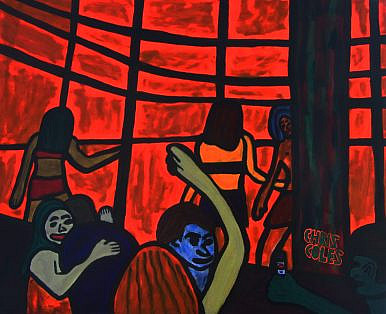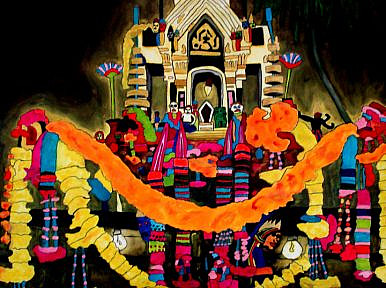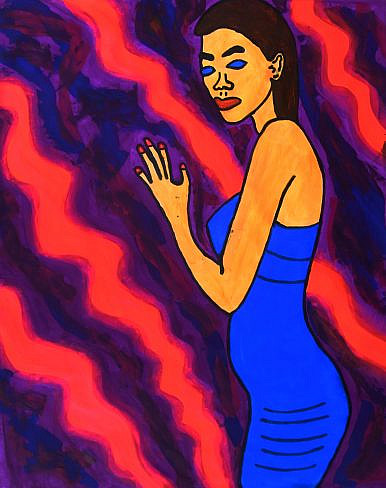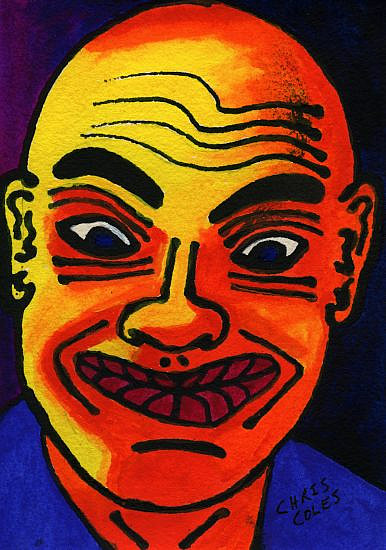DIPLOMAT Magazine/Jonathan DeHart - "An interview with American artist Chris Coles on his watercolor visions from the Bangkok NIght"...
Painting the Bangkok Night
The Diplomat has previously explored Bangkok’s thriving community of noir fiction writers, who have been deftly weaving the plots of misadventure and ruin playing out in the Thai capital night after night. These authors, including Christopher G. Moore, Tom Vater, John Burdett, James Newman and John Gartland, among many others, are in fact part of a larger artistic community, collectively drawing on the city’s cast of characters for inspiration.
Visual artists are another spoke on this creative wheel, mostly occupied by photojournalists who have extensively mined the darkest corners of Bangkok with camera in hand. Patpong: Bangkok’s Twilight Zone, a book-length photo essay by German photojournalist and author Nick Nostitz, is a stirring example. The images in the book – in both vivid colors and grainy black and white – depict the full spectrum of characters in Bangkok’s nightlife, from prostitutes to the many varieties of barfly who enter their world.
American artist Chris Coles approaches this world in a completely unique way, with watercolor paints and a brush in hand. His expressionist paintings, of which there are more than 2,000, add a brilliant splash of color to this scene and cast its familiar subjects in a fresh light. His eyes flit freely among bar girls and patrons, from Japanese businessmen to Bangkok old hands, capturing them honestly and humanizing them, but never idealizing the flesh trade. In the introduction to his book of paintings, Navigating the Bangkok Noir, author and friend Christopher G. Moore compares Coles to Henri de Toulouse-Lautrec, the French painter who captured the bohemian, often decadent nightlife world of Paris in the 19th Century, including numerous sympathetic portraits of prostitutes. Berlin’s nightlife in the 1920s and 1930s inspired a similar artistic movement.

Hollywood Bar Nana Plaza Source: Chris Coles
The Diplomat spoke to Coles about his journey that led him to the Bangkok Noir artistic community, what inspires his watercolor visions and what they really mean.
Briefly, what is your background professionally as well as with art? And how long have you spent living in Bangkok?
After graduating from the U.K. National Film School, I worked as a Line Producer/Production Manager/Location Manager in the movie business for about 25 years, mostly on big budget international films like Superman, LA Story, Chaplin and many others.
The last film I ever worked on with was a huge budget, completely dumb pirate movie called Cutthroat Island which we filmed in southern Thailand, in and around Phang-Nga Bay/Phuket.
Which was my introduction to modern Asia. Before that I knew nothing about what was happening in modern Asia/Southeast Asia. The tremendous change, huge social pressures, cultural richness, diversity of people. All of which I found to be very interesting.
After the filming was over, I went back to Los Angeles but started flying back and forth to Thailand and Asia/Southeast Asia to get more familiar with a part of the world which seemed to be in the middle of a unique once-in-two-thousand-year transformation, from third world backward to first world ultra-modern.
Then about 15 years ago, I bought a small condo in Bangkok’s Sukhumvit District to use as a kind of base camp to travel and explore more easily to and from China and around Southeast Asia.
Meanwhile, I was reading lots of books about modern Asia – history, politics as well as novels – and became friends with various writers and journalists in Bangkok, including the novelist Christopher G. Moore.
I’d always had a hobby of drawing, mainly pencil/graphite drawings, and I started doing a series of portraits drawn from the incredible diversity of faces you see wandering around Bangkok and Southeast Asia.
One evening, after spending a few hours browsing through art books at the wonderful Kinokuniya bookstore in the Sukhumkvit District’s Emporium Shopping Center, I was having a beer with Christopher Moore and we were talking about how incredibly similar some of the German Expressionist (Emil Nolde, George Groz, Otto Dix, Max Beckmann) paintings of Berlin nightlife in the 1920s and 1930s were to the various nightlife scenes in modern Bangkok.
I asked Chris if he knew of any artist, Farang or Thai, who was painting the Bangkok night and he said he couldn’t think of anyone. Then he looked at me and said, “Why don’t you do it?”
That was back around 2001 and since then I’ve done over two thousand paintings from the Bangkok night.

Boys Town Bangkok Night Source: Chris Coles
What specifically about Bangkok drew you in? Could your work really have sprung out of any other city, or do you think Bangkok is uniquely suited for it?
My favorite paintings/artists by far are the German Expressionists. Especially Emil Nolde, George Groz, Otto Dix and Max Beckmann. I love the distortion, the wild use of color, the social context, implied stories and narrative. And their very noir vision of the world and the human animal.
A lot of the inspiration for my paintings is of course the noir-saturated, neon-lit Bangkok night. The crazy and extreme cast of characters, the bright clashing colors, the fabulous use of neon signage, the visual density, a unique visually rich platform/stage upon which the thousands of stories and relationships going on in the Bangkok night are played out.
It’s the perfect setting and metaphor for a noir dystopian vision of modern humanity – alienated relationships, love and desire gone awry, an ongoing collision between the first world and third world, a general messiness and near-chaos, tons of despair and endless human tragedy; but also a world with a sense of wonder, a touch of beauty and poignancy.
The Bangkok night’s got everything an artist painting in the Expressionist style will ever need…and I’m here to capture what’s there.
How much time did you spend getting to know people – on all sides of the bar – before you started painting their portraits?
My daily schedule in Bangkok is, wake up around 9 a.m., go to my hangout coffee place in the basement of a modern Bangkok office tower, do my Internet stuff, then eat lunch at the Thai food court on the top of the Terminal 21 Shopping Center before spending an hour in the gym.
Then back to my studio to paint for seven hours or so before heading over to Brainwake Cafe at the bottom of Sukhumvit Soi 33 for some Thai food or sometimes to a Japanese coffee place on Sukhumvit Soi 23.
Around 10 p.m., I head out into the Bangkok night, which spreads for miles in every direction….the Sukhumvit District, which is centered around Soi Cowboy, Soi 11, Soi Bin Laden and Soi Nana. The Silom/Surawong District centered around Patpong and Boys Town. The Ratchada District, which is a center for Thai and Asian nightlife. Or somewhere else for some special event/situation or to meet up with a friend.
One of the great things about the Bangkok night is that you regularly intersect with people from all over Asia and the world, from every income level, every ethnicity, every education level. Big, small, tall, short, fat, slim, smelly, svelte, well-dressed, and plenty of slobs. Muslim, Hindu, Buddhist, Christian, Jewish, Agnostic, Pagan. Basically the entire spectrum of humans on earth.
And because the Bangkok night is kind of a weird Duty-Free Zone for Humans, you can end up conversing or hanging out with people you might never otherwise meet. From Turkmenistan, Iran, China, Nigeria, Brazil, Saudi Arabia, Europe, Japan, wherever.
The Bangkok night has got to be one of the world’s most visually rich, high density, color saturated target areas for an artist (especially an Expressionist artist), anywhere in the world. And safe enough (at least if you know the “informal rules”) for an artist to just wander around in – unlike perhaps Lagos, Mexico City or Mumbai for instance.

Spirit House Japanese KTV Bangkok Night Source: Chris Coles
In the course of your explorations of the Bangkok night, are there a few individuals on any side of the transactional equation who made a particularly strong impact on you?
There have been a few people in particular in the Bangkok night who have been quite important influences to my paintings.
A mama-san who worked at a popular Patpong bar for over 20 years, who has seen hundreds of thousands of customers come and go and managed thousands of sex workers for instance.
When I first started painting the Bangkok night, I used to show her the paintings and ask her opinion. She helped me get the right tone and approach. If I was too soft, or the painting was too pretty, she would tell me I was being too sentimental. She would explain to me her point of view towards the customers, towards the girls. She taught me what a hard cold noir world and business the Bangkok night really was, underneath an often colorful surface filled with smiles, seduction and charm.
Another influential person who helped me is the French guy who owns some of the most successful, highest income bars in the Bangkok night. He sees the Bangkok night as very similar to the Paris nightlife scene circa 1900, one of the modern world’s great night entertainment spectacles, a gigantic show with a vast cast of characters, an endless variety of costumes.
He helped me understand how important the various details were. The precise nature of the lighting, seating layouts, the music track and audio system, the color palette and costumes, the right mix of personalities for the dancers and sex workers as well as the staff. How to create an atmosphere that draws in customers by the tens of thousands.
Then there are some of the sex workers without whom there would be no Bangkok night.
Especially one woman I’ve known for a long time, who has worked in the Bangkok night for over 20 years. A Muslim woman from Thailand’s impoverished Deep South who finished school at age 14, had a son when she was 15 and after the father and husband abandoned her, came to Bangkok at age 16 to work as a prostitute in the Bangkok night.
Economically successful, earning almost 10 times the average Thai income, she has put her son through university, bought a house and small business for her parents and owns a Bangkok condo and car. She is still stylish and striking at age 40.
Very controlled in terms of her diet, exercise routine (daily yoga) and how she conducts her business, she is tough, strong, perceptive and insightful. But also very cold.
I’ve done a bunch of paintings of her. She has even come to my Bangkok art show Openings sometimes, likes what I’m doing and, in many conversations, has shared her deep knowledge and experience of what it is to be a longtime sex worker in the Bangkok night. A setting and life that requires tremendous toughness, durability, resilience, survival skills and intuition.
The Bangkok night is Survival of the Fittest. Nothing fun about it, at least for the sex workers. Beneath the surface smiles, it’s all Noir all the time.

Khmer Girl at Pontoon Club Source: Chris Coles
Which artists do you count as your primary influences?
My favorite artist and mentor is the German Expressionist Emil Nolde who is a Master of color and distortion, as well as having a dark noir vision of the human animal. He lived and worked in Germany from before World War I through to after World War II….saw millions of people murdered and killed, immense cruelty, and near total social dislocation.
He started all of his paintings as small watercolors which he would then later make into large oil on canvas paintings, which is an idea I follow, also starting all of my paintings as small 5×7 or sometimes 10×15 inch watercolors.
My favorite art movement by far is German Expressionism, especially George Groz, Otto Dix and Max Beckmann, along with Nolde. The German Expressionists had a strong vision embedded in the social context of their time and they realized their vision with a powerful use of color and distortion.
Their paintings are not there just for “decoration.” They are disturbing, offensive. They force you to “wake up.”
What inspired you to adopt the watercolor style that has come to flavor your work? Is there something about its garish use of color, its indefinite lines, which is intended to say something about the nature of the people and scenes you are painting?
I use watercolors to make the first versions of all of my paintings, an idea I got from the great German Expressionist Emil Nolde who also used this method.
Watercolors are so quick, fluid, flexible, easily manipulated. I paint watercolors in a very wet style, lots of water splashing around on a flat surface, subtracting and re-adding with a sponge or paper tissue. Layers upon layers. You can get color mixing effects with watercolors which are almost impossible to imitate with acrylics or oil paints.
Nolde started his paintings as small watercolors to avoid hesitation or getting creatively blocked. A big blank canvas is so intimidating. If the design, color scheme and tone are worked out with watercolors on a small piece of paper, there is almost no hesitation. If the idea doesn’t work, it’s easy to just throw the piece of paper away.
In terms of watercolors and the Bangkok night, by midnight, things are getting blurry. The over-stimulation of the senses – visual, audio, smell, touch and contact, taste and food – makes your brain a little dizzy. Everything becomes fluid. All of which lends itself to being captured and portrayed by the fluidity and blur of the watercolor method and style.
I try to capture the mood, ambiance and feeling of being out and about in the Bangkok night, a setting in which you are mixed and blended with a mass of diverse humanity, colors, smells, tactile contact, multiple music tracks playing simultaneously. The neon signs, millions of tiny twinkle lights, thousands of mirror surfaces.
Watercolors are the best tool.
There are so many ways the scenes in your paintings could be interpreted – sad, dark, depraved, scary, colorful, compassionate, deeply human. On balance, what do you feel is the essential tone running through your work? Is there a moral aspect to it?
Some folks find my Expressionist style paintings from the Bangkok night offensive, and even accuse me of somehow “promoting” Thailand’s industrial-scale commercial sex industry.
But if you look closely at the paintings, very few of the sex workers portrayed are smiling, there is very little nudity and there is almost no actual sex going on.
The paintings are instead about the social situation, the context, and the people (customers, sex workers, staff) caught up in the situation and the context of modern Thailand’s extremely “unjust” social structure and embedded hierarchical relationships.
The distortion, extreme lighting, clashing colors and situations imply alienation, human deficits, lost potentials, lives that are adrift, cut loose from the moorings of an imagined “normalcy,” the opposite from the idea of harmonious families with settled routines.
Everything is taking place at night, with no sunlight, lots of neon, multi-colored blinking lights, strobe lights, twinkle lights, lots of shiny mirrors.
My view of the Bangkok night is very noir, very dark. A dangerous and harmful place where humans play out their many deficits and compulsions, needs and desires, without any conscience, ethics or morality, imagined or otherwise.
It’s a world full of Bad Intention, greed, unequal relationships and the Illusion of Desire.
At the heart of my noir vision of the Bangkok night are deeply flawed human animals, tragically flawed, caught up in endless obsessions and trapped by their limitations.
Human life on this earth as it is actually lived, not as we sometimes like to “pretend” it’s lived.

Dutch Guy at Crazy House Bar Source: Chris Coles
What do you think the place of your work is in the context of the larger Bangkok noir artistic movement (fiction, films, music, etc.)?
To me, the Bangkok Noir movement is similar to the German Expressionist movement — only set in modern Bangkok and Southeast Asia instead of Berlin and Central Europe in the early 1900’s.
In those days, Berlin and Central Europe were in the middle of transformation. A lot of tectonic shifts going on, a huge level of destruction and violence, World War I, World War II, lots of extreme behaviors, social structures under severe pressure, millions of humans at their breaking point. And the German Expressionists managed to capture it with their unsentimental lens and tone, fractured style, clashing colors and embedding their paintings in the social context of the time.
For myself and the other Bangkok Noir artists, writers, poets, musicians and filmmakers, we’re all making use of Bangkok and Southeast Asia’s noir social context. We’re using the extremes of characters, extreme diversity, high level of social injustice, “boxed-in” nature of Southeast Asia society with big men at the top and ordinary people with almost no rights or protections underneath as raw material for our work.
The Bangkok Noir Movement is comprised of a bunch of writers: Christopher G. Moore, John Burdett, Timothy Hallinan, Stephen Leather, Lawrence Osbourne, Kevin Cummings and others. A few poets such as John Gartland. Music groups like KROM. Some filmmakers and a few artists, myself and a Dutch Artist named Peter Klashorst being probably the most well known.
Also, there are some journalists and social and political writers whose reporting and books on various Southeast Asia noir situations has generated a large amount of raw material for the rest of us to make use of. Patrick Wynn, Wayne Hays, Jonathan Head, Nick Nostitz, Dan Rivers, Federico Ferrara, Andrew MacGregor Marshall, Claudio Sopranzetti and others.
They have researched and written many detailed stories on Thailand’s ultra-noir politics. The infinite amount of noir stuff that always seems to be going on, such as the use of slave labor in the Thai fishing industry, the plight of the Rohingya minority in Myanmar who are often trafficked thru Thailand onward to Malaysia under horrendous conditions, the deep level of endemic corruption, the mafias, injustice, the extreme un-fairness.
And of course Thailand’s industrial scale commercial sex industry, which spews out a deep wide river of noir as if it were the mighty Mekong.
There are more than 2,000 of my paintings from the Bangkok night. They are the visual component of the Bangkok Noir Movement, the visual storyboards for the overall larger noir narrative we are all working with and contributing to.
I know all of the Bangkok Noir contributors, and have read or seen their work. We are collectively working in the same gigantic open pit, noir goldmine, and our combined work as a whole may, at some future point in time, end up being an important element in how this particular transformative era in Southeast Asia will be viewed and remembered.
Are you still painting? If so, what are your future plans for your work? Has anything changed about your work that has come about since the release of your book of paintings Navigating the Bangkok Noir?
I paint every day. Right now, I’m working on a Pattaya Noir series, sort of an extension of Bangkok Noir, but dialed up, on a larger scale, bigger scenes, more detail.
I’ve spent quite a lot of time in Phnom Penh the past few years, a city – and a country (Cambodia) – in the midst of a total transformation, spitting out a vast amount of noir. I have done quite a few paintings inspired by Phnom Penh. I love the Khmer look – very defined faces, similar to the Angkor Wat statues.
Occasionally I do Expressionist-style flower paintings…a show I did Bangkok last year featured some of the flower paintings.
And maybe in a few years I will do some Expressionist-style paintings using the rocky timeless coast of Maine. In the manner of the great American Expressionist Marsden Hartley’s paintings of the Maine coast.
I spend a few months a year on the coast of Maine, near the town where I grew up, which is a total opposite of Bangkok and Southeast Asia in terms of the color palette, the social situation, and the people living there.
For more information on the Bangkok Noir movement and Chris Coles’ paintings, go to: www.bangkoknoir.com.
Labels: Bangkok night, Chris Coles, christopher g. moore, Diplomat Magazine, Emil Nolde, expressionism, Federico Ferrara, john burdett, Jonathan DeHart, Jonathan Head, Kevin Cummings, Lawrence Osbourne, Nick Nostitz